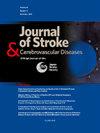营养和炎症状态对脑卒中患者死亡率的影响:NHANES 2005-2018的结果
IF 1.8
4区 医学
Q3 NEUROSCIENCES
Journal of Stroke & Cerebrovascular Diseases
Pub Date : 2025-04-30
DOI:10.1016/j.jstrokecerebrovasdis.2025.108334
引用次数: 0
摘要
脑卒中显著影响全球健康,是致残、痴呆和死亡的主要原因。营养缺乏和全身性炎症的相互作用在决定卒中预后方面起着关键作用。虽然预后营养指数(PNI)和晚期肺癌炎症指数(ALI)在多种疾病中的预后价值已得到认可,但其与脑卒中预后的相关性还有待进一步探讨。方法:本研究利用2005年至2018年美国国家健康与营养调查(NHANES)的数据,分析908名中风幸存者,研究PNI、ALI和死亡结果之间的关系。应用加权Cox比例风险模型评估相关性,控制人口统计学和健康相关变量。Kaplan-Meier曲线和受限三次样条分别用于评估生存差异和非线性关系。此外,还进行了亚组分析和敏感性分析,以验证这些关联的稳健性。结果在我们的队列中,PNI升高与全因死亡风险显著降低相关(危险比[HR]: 0.53, 95%可信区间[CI]: 0.37-0.75, p <;0.001)和心血管死亡率(HR: 0.60, 95% CI: 0.38-0.94, p = 0.028)。同样,较高的ALI水平与全因死亡风险降低相关(HR: 0.53, 95% CI: 0.37-0.72, p <;0.001),但调整后其对心血管死亡率的影响无统计学意义。亚组分析显示,性别、年龄和糖尿病状态调节了PNI/ALI与死亡率结局之间的关系,特别是在糖尿病患者中观察到显著的相互作用(相互作用的PNI: P = 0.025,相互作用的ALI: P = 0.007)。结论:本研究证实,较高的PNI和ALI与卒中幸存者较低的全因死亡率相关。PNI升高也可降低心血管死亡风险。性别、年龄和糖尿病状况影响这些关联。这些发现强调了监测营养和炎症状态在中风恢复中的重要性。本文章由计算机程序翻译,如有差异,请以英文原文为准。
The impact of nutritional and inflammatory status on mortality in stroke patients: Results from NHANES 2005-2018
Background
Stroke significantly impacts global health, being a primary cause of disability, dementia, and mortality. The interplay of nutritional deficiency and systemic inflammation plays a pivotal role in determining stroke outcomes. While the Prognostic Nutritional Index (PNI) and the Advanced Lung Cancer Inflammation Index (ALI) have been recognized for their prognostic value in various diseases, their relevance in stroke prognosis necessitates further exploration.
Methods
This study utilized data from the National Health and Nutrition Examination Survey (NHANES) from 2005 to 2018, analyzing 908 stroke survivors to examine the associations between PNI, ALI, and mortality outcomes. Weighted Cox proportional hazards models were applied to assess the associations, controlling for demographic and health-related variables. Kaplan–Meier curves and restricted cubic splines were used to evaluate survival differences and non-linear relationships, respectively. Additionally, subgroup and sensitivity analyses were conducted to verify the robustness of the associations.
Results
In our cohort, elevated PNI was associated with significantly lower risks of all-cause mortality (Hazard Ratio [HR]: 0.53, 95 % Confidence Interval [CI]: 0.37–0.75, p < 0.001) and cardiovascular mortality (HR: 0.60, 95 % CI: 0.38–0.94, p = 0.028). Similarly, higher ALI levels correlated with a reduced risk of all-cause mortality (HR: 0.53, 95 % CI: 0.37–0.72, p < 0.001), though its impact on cardiovascular mortality did not reach statistical significance after adjustment. Subgroup analysis revealed that gender, age, and diabetes status modulated the relationship between PNI/ALI and mortality outcomes, with significant interactions observed especially in diabetic patients (PNI: P for interaction = 0.025 and ALI: P for interaction = 0.007).
Conclusions
This study confirms that higher PNI and ALI are associated with lower all-cause mortality in stroke survivors. Elevated PNI also reduces cardiovascular mortality risk. Gender, age, and diabetes status influence these associations. These findings highlight the importance of monitoring nutritional and inflammatory status in stroke recovery.
求助全文
通过发布文献求助,成功后即可免费获取论文全文。
去求助
来源期刊

Journal of Stroke & Cerebrovascular Diseases
Medicine-Surgery
CiteScore
5.00
自引率
4.00%
发文量
583
审稿时长
62 days
期刊介绍:
The Journal of Stroke & Cerebrovascular Diseases publishes original papers on basic and clinical science related to the fields of stroke and cerebrovascular diseases. The Journal also features review articles, controversies, methods and technical notes, selected case reports and other original articles of special nature. Its editorial mission is to focus on prevention and repair of cerebrovascular disease. Clinical papers emphasize medical and surgical aspects of stroke, clinical trials and design, epidemiology, stroke care delivery systems and outcomes, imaging sciences and rehabilitation of stroke. The Journal will be of special interest to specialists involved in caring for patients with cerebrovascular disease, including neurologists, neurosurgeons and cardiologists.
 求助内容:
求助内容: 应助结果提醒方式:
应助结果提醒方式:


